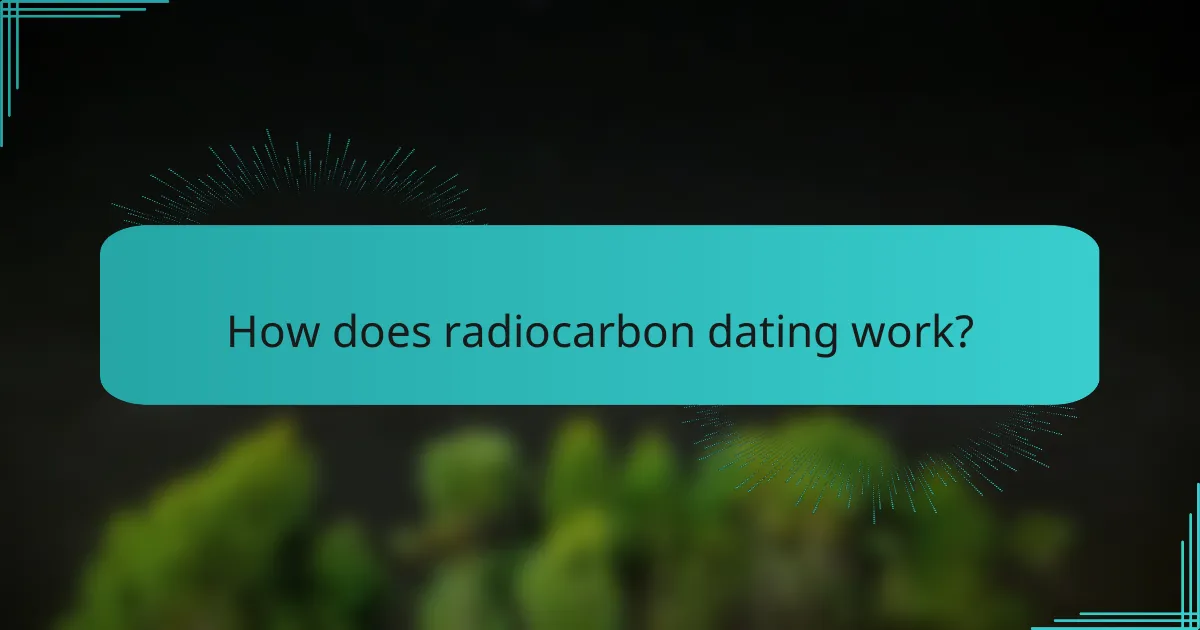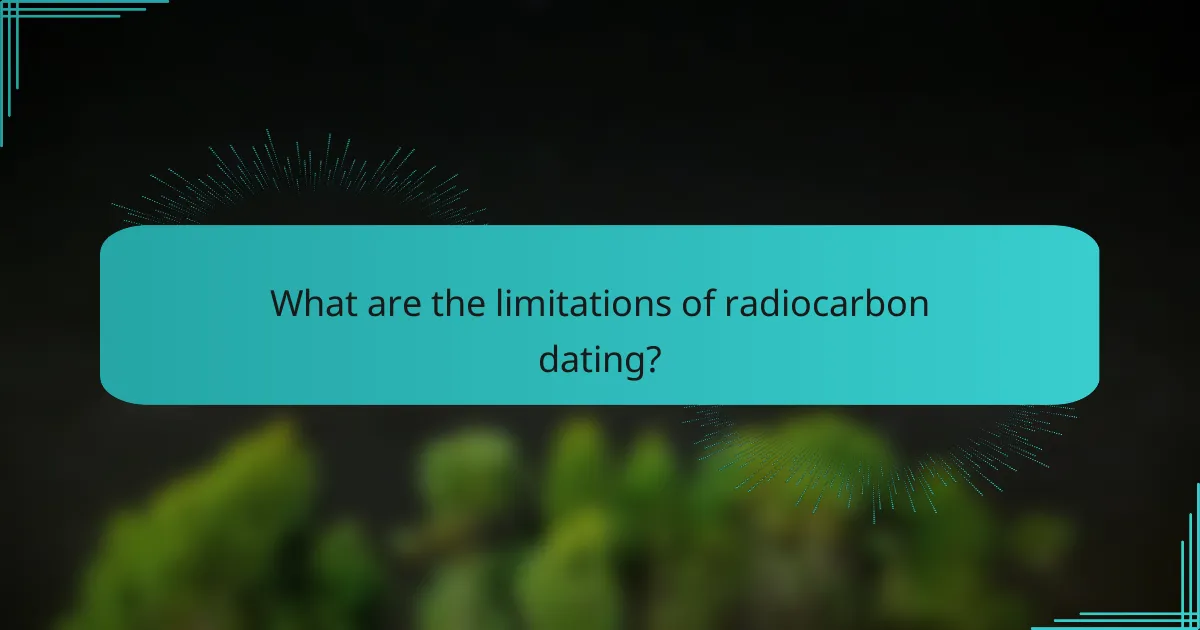Dating methods such as radiocarbon dating, stratigraphy, and contextual analysis are essential tools in archaeological research, each providing valuable insights into the age and context of artifacts. Radiocarbon dating allows for precise age estimation of organic materials, while stratigraphy analyzes sediment layers to establish relative timelines. Together, these methods enhance our understanding of historical narratives and the development of human civilization.

What are the best dating methods for archaeological analysis?
The best dating methods for archaeological analysis include radiocarbon dating, stratigraphy, and contextual analysis. Each method offers unique insights into the age and context of artifacts, helping researchers construct a clearer picture of historical timelines.
Radiocarbon dating
Radiocarbon dating is a technique used to determine the age of organic materials by measuring the decay of carbon-14 isotopes. This method is effective for dating items up to about 50,000 years old, making it ideal for archaeological finds like bones, wood, and plant fibers.
When using radiocarbon dating, it is essential to consider contamination and calibration. Samples must be carefully collected and processed to avoid introducing modern carbon, which can skew results. Calibration curves, based on dendrochronology and other data, help refine age estimates.
Stratigraphy
Stratigraphy involves analyzing the layers of soil and sediment in which artifacts are found. This method relies on the principle of superposition, where lower layers are older than those above them. By examining these layers, archaeologists can establish a relative timeline of human activity.
Key considerations in stratigraphy include the context of each layer and potential disturbances caused by natural events or human activities. Understanding the sequence of layers can reveal insights into cultural changes over time, but it requires careful excavation to maintain the integrity of the site.
Contextual analysis
Contextual analysis focuses on the relationships between artifacts and their surrounding environment. This method assesses how items interact within their archaeological context, providing insights into their use and significance. It often involves examining spatial arrangements and associations with other finds.
To effectively conduct contextual analysis, researchers should document the location and orientation of artifacts meticulously. This approach can reveal patterns of behavior and social organization, enhancing the understanding of past cultures. However, it is crucial to avoid assumptions and to base interpretations on solid evidence.

How does radiocarbon dating work?
Radiocarbon dating measures the decay of the carbon-14 isotope in organic materials to estimate their age. This method is effective for dating items that are up to about 50,000 years old, providing a reliable way to determine the age of archaeological and geological samples.
Carbon-14 isotope measurement
Carbon-14 is a radioactive isotope formed in the atmosphere when cosmic rays interact with nitrogen. Living organisms absorb carbon, including carbon-14, from the atmosphere and their food. Once they die, they stop taking in carbon, and the carbon-14 begins to decay at a known rate, allowing scientists to calculate the time since death based on the remaining carbon-14 levels.
Typically, the half-life of carbon-14 is about 5,730 years, meaning that after this period, half of the original carbon-14 in a sample will have decayed. By measuring the ratio of carbon-14 to carbon-12 in a sample, researchers can estimate its age within a reasonable range.
Calibration with dendrochronology
Calibration is crucial for improving the accuracy of radiocarbon dating. Dendrochronology, or tree-ring dating, provides a method to compare radiocarbon dates with calendar years. By analyzing tree rings, researchers can create a timeline of atmospheric carbon-14 levels over the years.
This calibration process allows for adjustments based on variations in carbon-14 production and atmospheric conditions, resulting in more precise dating. For example, a radiocarbon date of 2,000 years ago may be calibrated to a specific year, enhancing the reliability of the dating results.

What are the advantages of stratigraphy in dating?
Stratigraphy offers several advantages in dating by examining the layers of sediment and rock to determine the relative ages of archaeological finds. This method helps establish a chronological sequence based on the principle that deeper layers are typically older than those above them.
Layered sediment analysis
Layered sediment analysis involves studying the distinct layers of soil and rock to identify changes over time. Each layer, or stratum, can contain artifacts or fossils that provide insights into the environmental conditions and human activity during that period. For example, a layer rich in charcoal may indicate past fire use, while a layer with marine shells could suggest a coastal environment.
When conducting layered sediment analysis, it is crucial to document the depth and context of each find. This ensures accurate correlations between layers and helps avoid misinterpretations. A common pitfall is overlooking subtle variations in color or texture, which can indicate significant chronological shifts.
Relative dating techniques
Relative dating techniques utilize stratigraphy to determine the age of artifacts in relation to one another rather than providing an exact date. By analyzing the sequence of layers and the position of artifacts within those layers, archaeologists can establish a timeline of human activity. For instance, if a pottery shard is found in the same layer as a stone tool, it can be inferred that they were used during the same period.
Common relative dating methods include biostratigraphy, which uses fossil content to correlate layers, and lithostratigraphy, which focuses on the physical characteristics of rock layers. These techniques are often used in conjunction with other dating methods, such as radiocarbon dating, to enhance accuracy. However, it is essential to recognize that relative dating does not provide specific dates, making it less precise than absolute dating methods.

How is contextual analysis applied in dating?
Contextual analysis in dating involves examining the relationships between artifacts and their surroundings to determine their age and significance. This method provides insights into the cultural and temporal context of archaeological finds, enhancing the accuracy of dating methods like radiocarbon dating and stratigraphy.
Artifact association
Artifact association focuses on the relationships between different objects found together at a site. By analyzing these associations, archaeologists can infer the chronological sequence of the artifacts, which helps establish a timeline for human activity. For example, if a pottery shard is found alongside a coin from a specific era, it can suggest a date range for the pottery’s use.
When assessing artifact associations, it’s crucial to consider the context in which items are found. Items from the same layer of soil or within close proximity are more likely to be contemporaneous. However, disturbances such as natural erosion or human activity can complicate these associations, leading to potential misinterpretations.
Site-specific interpretation
Site-specific interpretation involves analyzing the unique characteristics of an archaeological site to understand its historical significance. Factors such as location, environmental conditions, and the layout of artifacts contribute to a deeper understanding of the site’s chronology and cultural context. For instance, a site near a water source may indicate settlement patterns related to resource availability.
To effectively interpret a site, researchers should integrate various forms of evidence, including stratigraphy, artifact types, and historical records. This holistic approach allows for a more nuanced understanding of the site’s development over time. Common pitfalls include over-relying on a single type of evidence or failing to account for external influences, such as trade or migration, that may have affected the site’s history.

What are the limitations of radiocarbon dating?
Radiocarbon dating has several limitations that can affect its accuracy and reliability. Key constraints include age range limitations and potential sample contamination, which can lead to misleading results.
Age range constraints
Radiocarbon dating is effective for dating organic materials up to about 50,000 years old. Beyond this range, the amount of carbon-14 becomes too low to measure accurately, making it unreliable for older samples. For example, materials older than 50,000 years may yield results that are not meaningful.
Additionally, the method is less effective for samples that are younger than a few hundred years, as modern carbon sources can skew results. This necessitates careful selection of samples to ensure they fall within the appropriate age range for accurate dating.
Sample contamination issues
Contamination is a significant concern in radiocarbon dating, as foreign carbon can alter the results. For instance, if a sample has been exposed to modern carbon sources, such as soil or handling, it can lead to younger apparent ages. This is particularly problematic in archaeological contexts where samples may be disturbed.
To mitigate contamination risks, researchers should follow strict protocols during sample collection and processing. This includes using clean tools, avoiding direct contact, and storing samples in contamination-free environments. Regular calibration with known standards can also help identify and correct for contamination effects.

What factors influence the choice of dating method?
The choice of dating method is influenced by site characteristics and research objectives. Factors such as the type of materials available, the age range of the artifacts, and the specific goals of the research play a crucial role in determining the most suitable dating technique.
Site characteristics
Site characteristics include the geological context, the types of materials present, and the preservation conditions. For instance, radiocarbon dating is effective for organic materials like wood or bone, typically up to about 50,000 years old, while stratigraphy relies on the layering of soil and artifacts to establish relative timelines.
Additionally, the environmental conditions at the site can affect the choice of method. For example, in arid regions, organic materials may be better preserved, making radiocarbon dating more viable, whereas in wet conditions, stratigraphic analysis might be more informative due to sediment accumulation patterns.
Research objectives
Research objectives dictate the level of precision and type of information needed from the dating method. If the goal is to establish a chronological framework for a site, stratigraphy might be preferred for its ability to provide relative dates. In contrast, if absolute dates are required, radiocarbon dating would be more appropriate.
Furthermore, the specific questions being addressed can influence method selection. For example, if researchers are interested in understanding the duration of human occupation, they may use a combination of radiocarbon dating for organic remains and stratigraphy for contextual analysis of artifacts.

How do dating methods compare in accuracy?
Dating methods vary in accuracy based on their principles and applications. Radiocarbon dating is highly precise for organic materials, while stratigraphy and contextual analysis provide relative dating, which can be less exact but offers valuable chronological context.
Precision of radiocarbon dating
Radiocarbon dating measures the decay of carbon-14 in organic materials, allowing for dating up to about 50,000 years old. This method is considered highly accurate, with a typical error margin of around 30 to 50 years for samples younger than 10,000 years.
However, factors such as contamination and calibration against other dating methods can affect results. For best practices, ensure samples are collected and stored properly to avoid contamination, and use calibration curves for more accurate age estimates.


